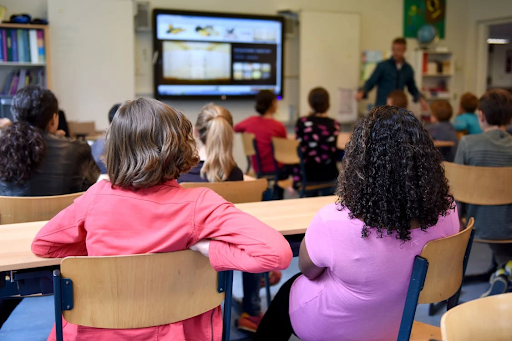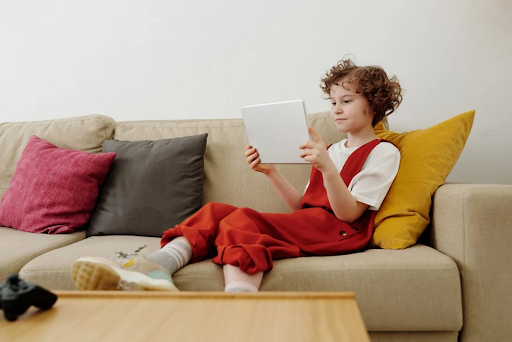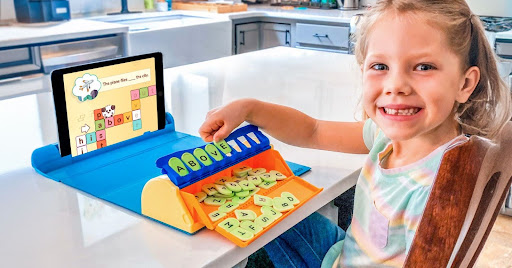
Augmented Reality (AR) overlays digital information onto the real world, adding an interactive layer that blurs the distinctions between physical and virtual environments. This can turn the abstract, intangible nature of learning inside out. Imagine students moving their way through 3D model solar systems on a tablet or exploring the human body dissected in layers sans scalpel.
The increasing number of schools implementing AR-powered tools into their curricula can serve as testimony to the growing interest in such tools. AR helps cater to various learning styles because it is both visual and kinesthetic, an experience that may not be fulfilled by traditional means. As AR technology becomes more accessible, it is likely that more classrooms will adopt it because AR makes learning more immersive, interactive, and effective.
What is Augmented Reality in Education?
Augmented Reality (AR) in education is understood as a technology that aims to enhance one’s environment – which is the real world – by adding some digital information to it in the form of images, video animation, or 3D designs. Thus, making learning and teaching very interactive too. This is done by using devices like tablets, mobile phones, or even AR glasses that can scan the environment using cameras and sensors so as to superimpose learning materials.
The way AR works in this regard is to overlay digital elements on top of conventional teaching materials. A textbook of history, for instance, could have a QR code that lets the student scan it using a tablet and thus pop up a 3D model of a relic from an ancient civilization. Science students can see, rather than just imagine, processes like cell division or chemical reactions in a far more intuitive way. Another interactive way AR applications can further help students is by providing them with step-by-step, hands-on instructions for various activities.
By deploying AR, educators will be able to develop lessons that will be more engaging, accessible, and accommodating to varied learning styles. The introduction of technology creates a new avenue through which the gaps between theoretical knowledge and its practical application can be bridged. Learning has not only been made more effective but also more enjoyable.
Key Benefits of Augmented Reality in Education
Enhanced Engagement and Interaction

Augmented reality makes interactive learning more efficient and creates an immersive experience by inserting digital elements into real-world environments. No longer do students sit back, absorb information, and pass it all off as knowledge spooned into their minds. Rather, this is making students take part in the learning process. For example, one can use AR to transform a lesson on geography into a virtual expedition to different terrains and climates. All these breathe life into the imagination of the student so that learning becomes a journey in itself.
Improved Understanding of Complex Concepts
One of the advantages of AR is the ability to break down difficult concepts by facilitating the use of images and animations that enhance the imagination. As an example, AR in anatomy classes has made it possible to see 3D models of a human body to learn about each of the organs. Likewise, in astronomy classes, students can look at the solar system, study the movements of planets, and even simulate some space events. These detailed visual aids demystify intricate topics, aiding in better understanding and retention.
Increased Retention and Memory
Multisensory learning through Augmented Reality (AR) significantly impacts memory retention by engaging multiple senses simultaneously. When students see, hear, and interact with AR content, they are more likely to remember the information. Studies have shown that AR-based learning tools improve recall by providing immersive experiences that make lessons more memorable. For instance, students using AR to study biology may recall details better because they can virtually manipulate cells and organs, making the learning experience more concrete and lasting.
Support for Diverse Learning Styles
AR caters to diverse learning styles by offering visual, kinesthetic, and auditory elements within a single platform. Visual learners benefit from detailed 3D models and animations, while kinesthetic learners gain from hands-on learnings. When considering sound as a complementary element of the learning material, auditory learners can enjoy listening to accompanying narrations or other sounds. This universal method ensures that every pupil, irrespective of their learning styles, can effectively consume the content. AR creates and promotes more equitable classrooms by providing varied and flexible learning conditions conducive to the academic flourishment of all students.
Real-World Connections
Overcoming the hurdles of classroom learning is possible with the use of Augmented Reality (AR) technology because it integrates interactivity and real-life functioning into practical learning. In engineering classes, for instance, students can use AR and view structural designs in 3D to better understand the working relationships of the structures to the surrounding environment. Case studies have demonstrated that AR goes beyond the theoretical direction to bring certain realities to action, for example, by virtually demonstrating concepts like gravitational force, which helps learners grasp such principles better.
Motivation and Participation
AR encourages student participation by incorporating gamification elements into the learning process. Interactive games and challenges transform lessons into engaging activities, motivating students to actively participate. For instance, language classes can use AR to create scavenger hunts that reinforce vocabulary through immersive scenarios. These fun, competitive experiences not only make learning enjoyable but also foster a collaborative environment where students are eager to engage and excel.
How Plugo Uses AR for Learning Effectively

Plugo toys by PlayShifu ingeniously blend physical play with digital learning through Augmented Reality (AR), creating hands-on, interactive educational experiences. Using AR-enabled games, Plugo offers engaging activities that align with different educational levels, from early childhood to advanced learners.
These games adapt to individual learning needs, ensuring that students stay motivated and challenged. By combining tangible play with digital content, Plugo transforms traditional education methods, making learning both dynamic and enjoyable across a range of subjects, including math, language, coding, music, and more.
Conclusion
Augmented reality in education will benefit from many advantages, from increased engagement to taking complicated subjects and making them easier to understand. It enhances the learning experience since using AR allows for ideas to be understood more fully and in a much more memorable fashion by providing a variety of paths to learning. Education, this way, is not only more effective but enjoyable for students of any age.
For educators and parents, adopting AR tools like Plugo provides an innovative way to make learning dynamic and engaging. Plugo seamlessly combines physical play with digital learning, making it a versatile tool for a range of educational levels. By exploring AR toys from PlayShifu, you can provide children with interactive experiences that foster curiosity and a love for learning. Embracing these technologies can transform the educational landscape, making it more inclusive and accessible for every learner.
FAQs:
1. How does AR improve student engagement in the classroom?
AR improves student engagement by transforming passive learning into an interactive adventure, making lessons more enjoyable and memorable through immersive experiences like virtual field trips and gamified challenges.
2. Can AR help with understanding complex subjects?
Yes, AR simplifies complex subjects by providing visual and interactive representations, making abstract concepts easier to grasp, such as using 3D models to explore anatomy or astronomy.
3. What are some examples of AR applications in education?
Examples of AR applications in education include virtual dissections in biology, interactive 3D models in history, and gamified vocabulary exercises in language classes.
4. Are there challenges in implementing AR in schools?
Challenges in implementing AR in schools include the need for appropriate devices, training for educators, and ensuring equal access for all students.

